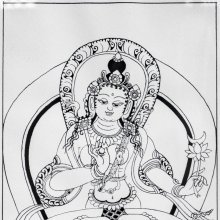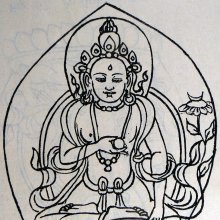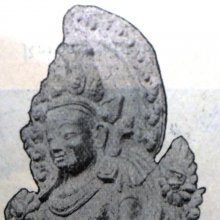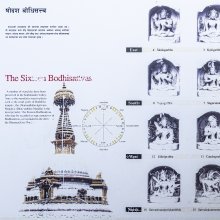Ratnapani, Ratnapāṇi: 10 definitions
Introduction:
Ratnapani means something in Buddhism, Pali, Hinduism, Sanskrit. If you want to know the exact meaning, history, etymology or English translation of this term then check out the descriptions on this page. Add your comment or reference to a book if you want to contribute to this summary article.
Images (photo gallery)
In Hinduism
Vyakarana (Sanskrit grammar)
Source: Wikisource: A dictionary of Sanskrit grammarRatnapāṇi (रत्नपाणि).—A grammarian of the eighteenth century who wrote a short treatise on the Karaka relations named षट्कारकविवरण (ṣaṭkārakavivaraṇa).

Vyakarana (व्याकरण, vyākaraṇa) refers to Sanskrit grammar and represents one of the six additional sciences (vedanga) to be studied along with the Vedas. Vyakarana concerns itself with the rules of Sanskrit grammar and linguistic analysis in order to establish the correct context of words and sentences.
In Buddhism
Tibetan Buddhism (Vajrayana or tantric Buddhism)
Source: Wisdom Library: Tibetan BuddhismRatnapāṇi (रत्नपाणि) is the name of a Bodhisattva mentioned as attending the teachings in the 6th century Mañjuśrīmūlakalpa: one of the largest Kriyā Tantras devoted to Mañjuśrī (the Bodhisattva of wisdom) representing an encyclopedia of knowledge primarily concerned with ritualistic elements in Buddhism. The teachings in this text originate from Mañjuśrī and were taught to and by Buddha Śākyamuni in the presence of a large audience (including Ratnapāṇi).
Source: archive.org: The Indian Buddhist Iconography1) Ratnapāṇi (रत्नपाणि) is the name of the Bodhisattva offspring associated with Ratnasambhava: one of the Dhyāni-Buddhas, according to Vajrayāna or Tantric Buddhism.—His colour is yellow; and his symbol is the jewel.—Ratnapāṇi, as the name signifies, belongs to the Ratnakula whichis presided over by the Dhyāni Buddha Ratnasambhava, whose spiritual consort is Vajradhātvīśvarī. Ratnapāṇi is of the same nature as the Dhyāni Buddha and when represented, he either stands erect, or sits in different sitting postures. He holds the stalk of a lotus on which appears the Kula symbol which is here the Jewel (Ratnacchaṭā). He is represented sparingly in the Buddhist Countries of the North, and a metal image of his found in Nepal [...]. Ratnapāṇi is known andrepresented in Tibet.
2) Ratnapāṇi (रत्नपाणि) is the name of a Bodhisattva commonly depicted in Buddhist Iconography, and mentioned in the 11th-century Niṣpannayogāvalī of Mahāpaṇḍita Abhayākara.—his color is green; his symbol is the jewel or the moon.—Ratnapāṇi is the Bodhisattva of the Dhyāni Buddha Ratnasambhava and as such, he is sometimes represented in Nepal and Tibet. His image is not found in the Chinese collection.
Ratnapāṇi is described in the Niṣpannayogāvalī (Dharmadhātuvāgīśvara-maṇḍala) as follows:—
“Ratnapāṇi is green in colour, holds the jewel in the right hand, and the disc of the moon on lotus in the left hand”.
3) Ratnapāṇi (रत्नपाणि) or Ratnapāṇilokeśvara refers to number 47 of the 108 forms of Avalokiteśvara found in the Machhandar Vahal (Kathmanu, Nepal). [Machhandar or Machandar is another name for for Matsyendra.].
Accordingly,—
“Ratnapāṇi also is identical with [Avalokita Lokeśvara] in all respects, except that he holds the sword in his left hand and displays the Varada mudrā with his right.—Avalokita Lokeśvara also is one-faced and two-armed and sits in the same attitude on a lotus. He wields the sword in his right hand and holds the stem of a lotus against the chest with his left”.
The names of the 108 deities [viz., Ratnapāṇi] possbily originate from a Tantra included in the Kagyur which is named “the 108 names of Avalokiteshvara”, however it is not yet certain that this is the source for the Nepali descriptions. Tibetan Buddhism includes schools such as Nyingma, Kadampa, Kagyu and Gelug. Their primary canon of literature is divided in two broad categories: The Kangyur, which consists of Buddha’s words, and the Tengyur, which includes commentaries from various sources. Esotericism and tantra techniques (vajrayāna) are collected indepently.
Mahayana (major branch of Buddhism)
Source: academia.edu: A Study and Translation of the Gaganagañjaparipṛcchā1) Ratnapāṇi (रत्नपाणि) refers to “(having) jewels in one’s hands”, according to the Gaganagañjaparipṛcchā: the eighth chapter of the Mahāsaṃnipāta (a collection of Mahāyāna Buddhist Sūtras).—Accordingly, as Bodhisattva Gaganagañja explains to Bodhisattva Ratnaśrī what kind of concentration should be purified: “[...] (66) [when the Bodhisattvas attain] the concentration called ‘Splendor of jewels’, they will have jewels in their hands (ratnapāṇi); [...]”.
2) Ratnapāṇi (रत्नपाणि) is the name of a Bodhisattva, according to the Gaganagañjaparipṛcchā.—Accordingly, “Then the Bodhisattva Gaganagañja said this to the congregation of Bodhisattvas: ‘Sons of good family, may all of you elucidate the gates into the dharma of transcending the path of the works of Māra’ [...] The Bodhisattva Ratnapāṇi said: ‘When you grasp or possess something, the Māra will find your weak point; when you do not grasp any dharma, there will be no debate. Since being alone is free from duality, you should not be established with your thought nor basis, to say nothing of being established with the māra. Thus the Bodhisattva who is established in nothing transcends the sphere of the Māra’”.

Mahayana (महायान, mahāyāna) is a major branch of Buddhism focusing on the path of a Bodhisattva (spiritual aspirants/ enlightened beings). Extant literature is vast and primarely composed in the Sanskrit language. There are many sūtras of which some of the earliest are the various Prajñāpāramitā sūtras.
Languages of India and abroad
Sanskrit dictionary
Source: Cologne Digital Sanskrit Dictionaries: Edgerton Buddhist Hybrid Sanskrit DictionaryRatnapāṇi (रत्नपाणि).—name of a Bodhisattva: Mahāvyutpatti 655; Saddharmapuṇḍarīka 3.5; (Ārya-)Mañjuśrīmūlakalpa 425.19; Kāraṇḍavvūha 1.12; 17.1, etc. (plays prominent rôle in Kāraṇḍavvūha).
Source: Cologne Digital Sanskrit Dictionaries: Aufrecht Catalogus Catalogorum1) Ratnapāṇi (रत्नपाणि) as mentioned in Aufrecht’s Catalogus Catalogorum:—Ṣaṭkārakapratichandaka [grammatical]
2) Ratnapāṇi (रत्नपाणि):—son of Acyuta, father of Ravi (Kāvyaprakāśaṭīkā): Kāvyadarpaṇa.
Source: Cologne Digital Sanskrit Dictionaries: Monier-Williams Sanskrit-English Dictionary1) Ratnapāṇi (रत्नपाणि):—[=ratna-pāṇi] [from ratna] m. Name of a Bodhi-sattva, [Monier-Williams’ Buddhism 203]
2) [v.s. ...] of various authors, [Catalogue(s)]
[Sanskrit to German]
Sanskrit, also spelled संस्कृतम् (saṃskṛtam), is an ancient language of India commonly seen as the grandmother of the Indo-European language family (even English!). Closely allied with Prakrit and Pali, Sanskrit is more exhaustive in both grammar and terms and has the most extensive collection of literature in the world, greatly surpassing its sister-languages Greek and Latin.
Nepali dictionary
Source: unoes: Nepali-English DictionaryRatnapāṇi (रत्नपाणि):—n. (Buddhism) one of the five Bodhisatwas (son of Ratnasamvabh);
Nepali is the primary language of the Nepalese people counting almost 20 million native speakers. The country of Nepal is situated in the Himalaya mountain range to the north of India.
See also (Relevant definitions)
Starts with: Ratnapani sharman, Ratnapanilokeshvara.
Ends with: Sarvaratnapani.
Full-text (+171): Maheshvarasimha, Ratnasambhav, Shatkarakapratichandaka, Nadiparikshadicikitsakathana, Vratacara, Krishnarcanacandrika, Mahadanavakyavali, Mithileshahnika, Kshayamasadiviveka, Ekoddishtasarini, Malamasasarini, Prayashcittaparijata, Parvanacandrika, Tithitattvacintamani, Jivesha, Jiveshvara, Chattrasimha khandabalanvaya, Dvaitaparishishta, Acarasamgraha, Ramacandra mishra.
Relevant text
Search found 5 books and stories containing Ratnapani, Ratnapāṇi, Ratna-pani, Ratna-pāṇi; (plurals include: Ratnapanis, Ratnapāṇis, panis, pāṇis). You can also click to the full overview containing English textual excerpts. Below are direct links for the most relevant articles:
Sripura (Archaeological Survey) (by Bikash Chandra Pradhan)
Scultures of Ratnapani < [Chapter 3 - Sculptural Programme]
Bronze-icons < [Chapter 3 - Sculptural Programme]
Scultures of Bodhisattvas < [Chapter 3 - Sculptural Programme]
The Indian Buddhist Iconography (by Benoytosh Bhattachacharyya)
The gods of northern Buddhism (by Alice Getty)
Vimalakirti Nirdesa Sutra (by Robert A. F. Thurman)
A Dictionary Of Chinese Buddhist Terms (by William Edward Soothill)





